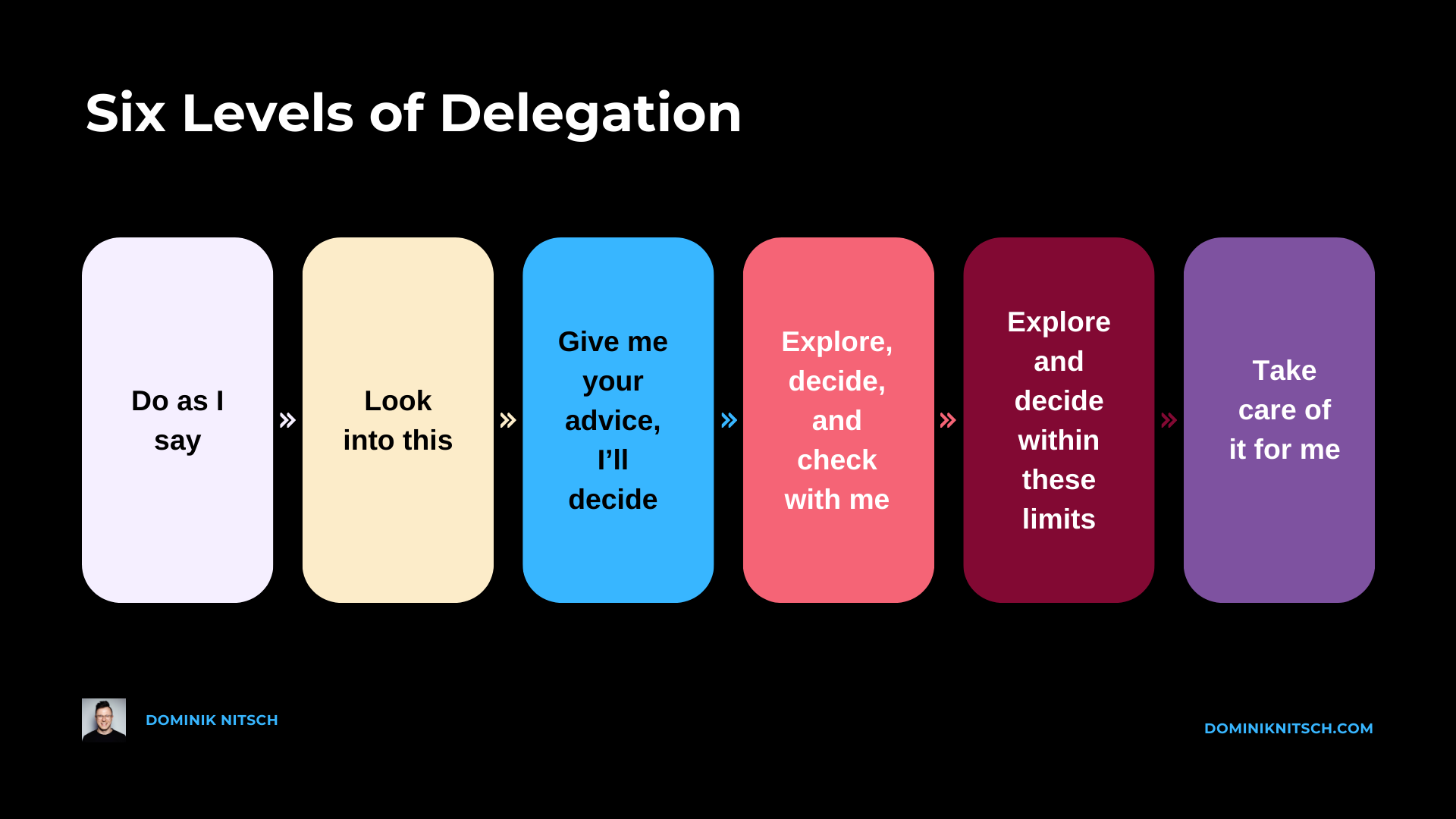IG#21: The Six Levels of Delegation
Are you struggling to delegate your tasks? Here's a helpful framework for you, + 2 productivity hacks from Marc Andreesen himself, + more.

Hey friends & happy Sunday!
Today, I want to try a slightly different format: a format that I call 12X. Instead of getting the 3-5 bullets you’re used to, you’ll be getting:
- 1 deep dive into a specific topic
- 2 nuggets of information, usually coupled with an action item
- X links to interesting stuff that I’ve written elsewhere or otherwise dug up
Initially, I had plans to make this a weekly publication: post 3-5 bullets every other week, and write a long form blog post on the other Sundays.
However, a weekly cadence seems a bit excessive. We already receive so many newsletters, and I’ve noticed that I simply stopped reading the ones that went out too often.
By only sending you high quality content every 2 weeks, I hope that my stuff will make it through that filter.
With that out of the way, let’s begin.
[1 Deep Dive]: The Six Levels of Delegation
“Ah, fuck it, I’ll just do it myself.”
A typical statement of someone struggling to delegate.
Delegation is a key skill for any manager.
It also seems to be the hardest one to acquire.
Last year, I was managing a team of 8 direct reports. That’s already more than enough for a full-time manager, but I was still spending ~18 hours per week on doing operational work myself.
You don’t need to be a management guru to understand that that’s not gonna work.
The problem: I couldn’t delegate things. Or, more specifically, I didn’t feel like I could delegate things.
So I turned to my management coach, Bob, for help. And boy, did he deliver.
Bob introduced me to the six levels of delegation:

Let’s walk through each one:
[Level 1] Do as I say
The most elementary level. This is where your trust in your employee is basically non-existent, you inspect the work regularly, and micromanage them to no avail.
[Level 2] Look into this
Now, your employee gets less granular instructions, but you still make all the decisions and digest the information. You only delegate the “how”, but not the “what” and the decision.
[Level 3] Give me your advice, and I’ll decide
Here, you’ve delegated the “how” and the “what”, but still own the decision. Your employee gives you advice, but decision power remains fully with you.
[Level 4] Explore, decide, and check with me
Now it’s getting interesting. Your employee is now at the level to make decisions on her own, only the final veto remains with you. This allows you still to calibrate, but overall, you’re getting ready to fully let go.
[Level 5] Explore and decide within these limits
Your employee is operating autonomously. You set the course, and only want a veto if the decision is big (could be a Type 1 vs Type 2 Decision, or a large purchase). Most companies have a policy where you can just buy stuff within a certain budget, depending on your hierarchy level. Note that on Level 5, the limits can go up.
[Level 6] Take care of it for me
The ultimate star employee. You fully delegate a task and never look back. Of course, you’ll still check in here and there, but you trust them to make the right call.
Each of your direct reports falls into one of these levels. You probably already have a pretty good idea who is where.
Now, let’s put the six levels of delegation into practice:
- For each of your direct reports, assess on which level they currently are (from your point of view).
- Then share this framework with them, and tell them where you see them. Transparency is key here.
- Together, identify what it would take in order to get to the next level. Write this down and define a time frame.
- Then, execute the actions.
Usually, you delegate tasks in the way corresponding to the current level. After that has worked for a few times, the employee can then move to the next level. Rinse and repeat.
This framework may seem simple, but for me, it was a total game changer.
I hope it does the same for you!
[2 Nuggets]: Marc Andreessen’s prime productivity hacks
Marc Andreessen is a legend in the Startup world.
And when legends write, we read.
Marc used to have a blog. He took it down, but one kind person managed to salvage it and put it up on GitHub, where it resides today.
One of the pieces is titled “The Guide To Personal Productivity”.
As someone who has read them all, I was intrigued. Was there still something new to learn?
Turns out, there was. Two things, to be specific:
[1] Use index cards as task management tool
Like myself, Marc is an avid user of index cards. He struggled as he was consistently drowning in todos from his list, not knowing which ones to tackle next.
Simple solution: the night before, write your top 5 tasks down. Do these, and nothing else until you're done with them.
Everything else you do on top is a bonus.
I've played around with this method in the past weeks, and really like it. Writing things on paper the night before is calming.
I write out:
- The top 5 things I want to achieve tomorrow
- Any other small wins that I could get out of the way
- And, during the day, everything that I managed to get done (really helps with impostor syndrome to go back and see all the things you did)
ACTION ITEM: Get yourself a stack of index cards and try this technique.
[2] Not keeping a schedule
WTF?! *shudders*
But Marc, keeping a schedule is the KEY to high productivity.
Turns out, not everyone operates the same way.
Some people are steady, and generate similar outputs on a daily basis.
Some are “switch-on, switch-off” and do their work in highly intense sprints, while being rather unproductive the vast majority of time.
As Mario Gabriele of The Generalist describes it (similarities between our publication names are pure coincidence):
“I have a theory. There are two types of professionals: “dimmer switches” and “flip switches.” Dimmer switch professionals have the gift of gradation. They are capable of adjusting their effort, turning the dial up or down to meet the task at hand or accommodate their abilities on a given day. Flip-switch professionals do not operate by degree; they are either off or on. When off, they are more or less useless – at least by their standard. But when they are on, they beam with hard, bright light.”
I'm the dimmer switch type, so keeping a schedule works well for me.
But if you're the flip switch type, not keeping a schedule might be the answer to your problems.
(Provided that this is possible for you.)
You can find the full guide here.
ACTION ITEM: Try not keeping a schedule for a few days; see what happens.
[X links]: 4 more things to check out
- Why I absolutely hate voice messages
- An insightful reflection on the Israel-Palestine conflict from Tomas Pueyo (did you know that Israel was founded by Jews who wanted to have their own countries, so they bought land there and slowly but steadily settled it? I didn’t)
- Zoom Dysmorphia: How videoconferences impact our self-image
- A fantastic newsletter post from my friend Felix at BS Startup Advice on the concept of “Minimum Viable Tests” and why they’re better than directly building an MVP (if you’re believe that a lot of startup advice is nonsense, consider subscribing - I’ve enjoyed every issue!)
One ask from my side
I’ve been getting a lot of feedback that some of you really enjoy what I’m writing - which makes me feel giddy, warm, and fuzzy. Please keep that coming.
My friend Lea mentioned recently: “a few friends and myself love the newsletter - we don’t always agree with what you write, but it encourages discussions among us, and that’s awesome”.
I love hearing that. If everybody agreed all the time on the things that I write, this stuff would be boring as hell.
So if you feel anything like Lea, please tell a friend about this newsletter, and maybe even forward them this email. It’s the best thing you can do to help this newsletter grow.
The more people subscribe, the more time I’m forced to spend on writing the best possible newsletter. Again, everybody wins.
Thank you.
That’s it for this edition of International Generalist. Thanks for tuning in and reading!
Who’s behind International Generalist?
I’m Dominik, and every day, I try to figure out how to become a tiny bit more effective. Then, I share some of the lessons learned here.
When I’m not writing, I build the international business for Sdui - the Leading European SchoolOS -, play Lacrosse, lift weights and enjoy draft beers.
Here’s how else I can help you:
- Read the newsletter archive for more actionable nuggets
- Download your free copy of The Ultimate Guide to Time Management (how to reclaim 4 hours of your day)
- Connect on LinkedIn or Twitter for daily doses of insights
- Send me a question that you’re thinking about! I’m always looking for content that is relevant to YOU.
See you in two weeks!
Much love
Dominik
Dominik Nitsch Newsletter
Join the newsletter to receive the latest updates in your inbox.


